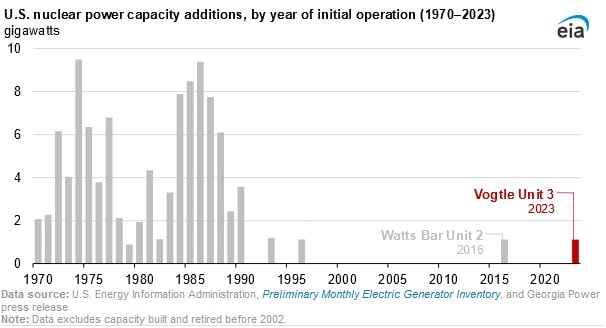First New Nuclear Reactor in Seven Years Begins Operations at Georgia’s Plant Vogtle: EIA

A new 1,114-megawatt reactor at Georgia’s Vogtle nuclear power plant has begun commercial operation, joining two existing reactors at the plant, which is jointly owned by Georgia Power and three other utility companies. This is the first new reactor to start up in the U.S. since the Tennessee Valley Authority’s Watts Bar 2 was commissioned in 2016, according to an Aug. 1 report from the U.S. Energy Information Administration.
Vogtle Unit 4 is in the final stages of construction and testing and projected to enter service in late 2023 or early 2024. The U.S. Energy Department’s loan guarantees to Georgia Power Company, a subsidiary of Southern Company, have financed the construction of units 3 and 4, marking the first U.S. deployment of the AP1000 Generation III+ reactor featuring advanced safety systems. Two Westinghouse AP1000 reactors were planned for a nuclear plant in South Carolina, but construction was stopped in 2017. Vogtle 3 and Vogtle 4 were originally expected to cost $14 billion and come online in 2016 and 2017, respectively, but the project ran into construction delays and cost overruns. The total cost of the project is now estimated to exceed $30 billion. The addition of Unit 3 and Unit 4 will make Vogtle the largest nuclear power facility in the U.S., exceeding the 4,120-megawatt Palo Verde plant in Arizona.
A number of nuclear reactors have retired since 2013 due to policy, structural changes in energy markets, and other economic factors. However, more recently there has been an attraction in nuclear energy as a fuel to reduce carbon emissions across the U.S. economy. Nuclear as an input fuel for electricity generation does not produce carbon emissions and provide vital baseload power that would otherwise come mostly from coal and natural gas, which both emit carbon dioxide.
The department recently issued application guidance for the second award cycle of the $6 billion Civil Nuclear Credit program established by the 2021 Infrastructure Investment and Jobs Act to prevent the premature retirement of nuclear reactors due to economic factors. The first award cycle resulted in the selection of the 2.2-gigawatt Diablo Canyon nuclear power plant in California.
The Biden Administration regards the current fleet of 93 nuclear reactors, which produces 95,881 megawatts of electricity, as a vital resource to achieve net-zero emissions across the economy by the year 2050. Currently, nuclear power generates about 20 percent of the nation’s electricity.
EnerKnol Pulses like this one are powered by the EnerKnol Platform—the first comprehensive database for real-time energy policy tracking. Sign up for a free trial below for access to key regulatory data and deep industry insights across the energy spectrum.
ACCESS FREE TRIAL